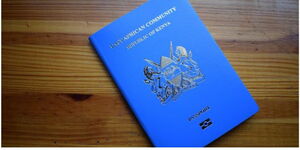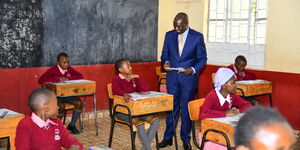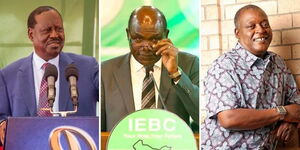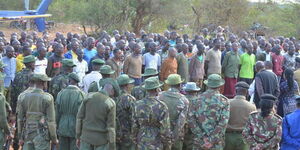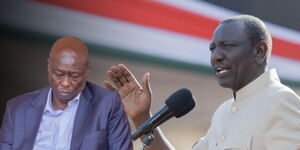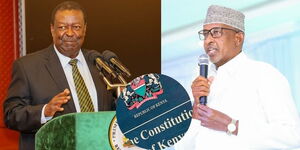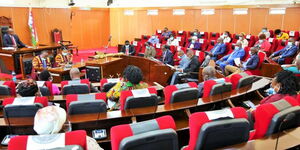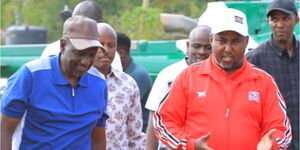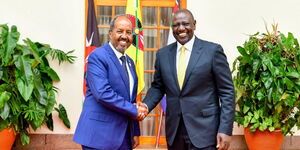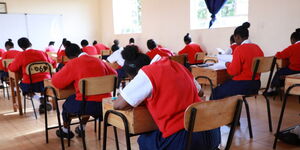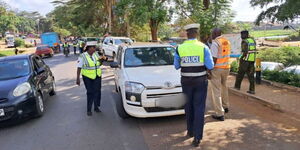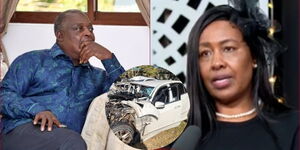The first elected Deputy President of Kenya Dr. William Samoei Ruto is the eleventh holder of the office (formerly the Vice-President of Kenya).
The self-proclaimed hustler has proven himself to be a charismatic politician who has smartly risen through the ranks, in a short span of time, to his current position as the second in command after President Uhuru Kenyatta.
Ruto was born on December 21, 1966 in Kamagut, Uasin Gishu to the late Mzee Daniel Cheruiyot and Mama Sarah Cheruiyot.
He attended Kerotet Primary School for his primary school education then joined Wareng Secondary School for his Ordinary Levels education before proceeding to Kapsabet Boys High School in Nandi County for his Advanced Levels.
It is believed that Ruto then did many unskilled jobs like that of vending groundnuts and chickens in the Nakuru-Eldoret road.
He then went on to receive a BSc (Botany and Zoology) from the University of Nairobi, graduating in 1990.
During his time in campus for the undergraduate course, Ruto was an active member of Christian Union where he served as Chairman.
After university, Ruto taught at Sirgoi and Kamagut Secondary Schools in the North Rift. At the same time, he founded African Venture Tours and Hotels.
Ruto later enrolled for MSc in Plant Ecology, graduating in 2011. In 2012, He enrolled for Ph.D. and after several setbacks, he eventually completed and was awarded a Ph.D. from the University of Nairobi graduating on December 21, 2018.
The title of his doctoral thesis was ‘Influence of human activities on land use changes on the environmental quality of riparian ecosystems: A case study of Saiwa Swamp watershed, Western Kenya’.
In 1991, he married his wife Rachel Chebet Ruto and have been blessed with six children:
1. Nick Ruto
2. June Ruto
3. Stephanie Ruto
4. Nadia Ruto (adopted)
5. Charlene Chelagat Ruto
6. George Kimutai Ruto
In February 2017, Prisca Chemutai Bett claimed that Ruto had fathered her 11-year-old daughter Abby Cherop Ruto, a claim that Ruto acknowledged.
Ruto’s political journey
Ruto’s journey to the second most powerful office in the land began during the multiparty election in 1992 when he successfully campaigned for KANU presidential candidate, retired President Daniel Arap Moi.
Reports indicate that Ruto’s staunch religious life is what contributed to him joining politics.
It is reported that his introduction to Retired President Moi happened during his days as the head of a choir at a local church.
Apparently, Moi had attended a service at the church and he got interested in Ruto’s personality after hearing his moving prayer.
Ruto was the Organising Secretary of Youth for Kanu '92 (YK92) popularly known as the “Young Turks”, a group that was formed to drum up support for Moi's re-election.
Soon after, he developed his own political ambitions that saw him successfully vie for the Eldoret North parliamentary seat in 1997.
Ruto's achievements
In 2002, he was elected as the Assistant Minister of Home Affairs, and in the same year, he was again elected to the Parliament.
Ruto became the Secretary-General of ‘Kenya African National Union’ (KANU) party, in the year 2005.
In 2006, he announced that he would contest the Presidential elections, which was to commence the next year.
However, this decision was not supported by his ‘KANU’ comrades.
In 2007, Ruto parted ways with the ‘Kenya African National Union’ (KANU) party and resigned from its secretarial post.
He then embarked to file for the candidature through the ‘Orange Democratic Movement’ (ODM) but failed to get a nomination after loosing to ODM leader Raila Odinga.
In the presidential elections of 2007, there were differences after the election commission announced the ‘National Rainbow Coalition’ candidate Mwai Kibaki as the president, while the exit polls showed that ODM's candidate, Odinga, as the winner.
However, Kibaki was elected as the President of Kenya and soon after, both Kibaki and Odinga came to a mutual understanding and decided to form a coalition cabinet.
The coalition cabinet was finally formed in 2008 and William Ruto was elected as its Agricultural Minister.
Ruto was then shifted to the Higher Education Ministry from the Ministry of Agriculture in the year 2010.
In 2011, the politician stepped down from his responsibilities as a minister, but he continued to be a Member of Parliament.
The ‘Law Society of Kenya’ (KSK) blacklisted some individuals on charges of corruption in the year 2012 and asked the public not to vote for the ones cited in the list.
Although Ruto’s name was in the list, he managed to get a huge number of votes the next year when he was a running mate to the current Kenyan President Uhuru Kenyatta.
Ruto along with Kenyatta formed the coalition party named ‘Jubilee Alliance’, that they used to contest the presidential election jointly.
In the 2013 Presidential Elections, Uhuru Kenyatta was voted as the President and William Ruto was elected as the Deputy President of Kenya.
Ruto’s controversies/scandals
Ruto’s name has appeared in many scandals over the years.
Some people have also widely claimed that he is corrupt and that he earned his wealth through dubious means.
Here are some of the scandals:
1. ICC case
Perhaps the most prominent skeleton in his closet is the ICC case.
In 2008, Kenya witnessed massive unrest. The unrests were attributed to election rigging.
As a team leader of ODM, Ruto was among the individuals who championed the unfolding of the truth that the then president Mwai Kibaki had lost the elections.
Ruto together with several other leaders who were allied to ODM proposed that President Mwai Kibaki should step down in favor of ODM’s Raila Odinga.
When the unrests and violence subsided, a commission of inquiry was formed to investigate the root causes of the violence.
The commission, Waki Commission, named twenty individuals and it is from the list that the retired ICC prosecutor, Moreno Ocampo picked the six suspects namely;
1. Uhuru Kenyatta (the current president of Kenya)
2. William Ruto
3. Francis Muthaura
4. Henry Kosgei
5. Major General Hussein Ali
6. Joshua Sang
7. Ruto was accused of crimes against humanity.
The ICC refused to acquit Ruto of any wrongdoing and termed the cases a ‘mistrial’. This was due to extensive witness interference and lack of state compliance with the court.
2. The maize scandal in the Grand Coalition Government
The scandal broke out in 2009. At the time, Ruto was the Minister for Agriculture in the Grand Coalition government.
PricewaterhouseCoopers carried out an audit which showed that Ruto used his personal assistant to write a letter asking that National Cereals and Produce Board allocates an individual 1,000 bags.
Ruto survived an impeachment motion after the Speaker rejected documents presented before parliament linking him to the maize scandal.
Ruto blamed his political opponents for linking him to the scandal.
3. The Hustler’s Jet scandal
This scandal took place in May 2013, a month after the Jubilee Government took power.
Deputy President William Ruto allegedly hired a private jet for Ksh100 million for his ‘shuttled diplomacy’ in West Africa.
The trip was to lobby West African countries to support their cause at the International Criminal Court (ICC).
The trip cost taxpayers Ksh21 million for transport and accommodation. This amount excluded allowances paid to the 14 people who accompanied Ruto.
The Parliamentary Accounts Committee (PAC) investigated the scandal. It state that Jubilee Government officials breached procurement regulations and procedures in the process of hiring the aircraft.
However, PAC absolved Ruto of any wrongdoing. It recommended several officials in his office to face prosecution.
However, parliament later threw out this report and no one took responsibility.
4. Lang’ata Primary School land grab
Some ‘faceless’ developers tried to grab the Lang’ata Primary School playground in 2015. Ruto’s name featured prominently in the scandal.
In response to the attempt, irate pupils led by a group of activists demonstrated against the land grab.
They attempted to bring down a perimeter wall built around the playground. The children carried placards proclaiming ‘Land grabbing is terror against children’.
The police responded ruthlessly and tear-gassed innocent schoolchildren. The aftermath was public outcry locally and around the world on how the police handled the protest.
Kibra MP Ken Okoth stated that the people took at least 10 children to the hospital with injuries. The injuries included tear gas exposure to their eyes.
Initially, Ruto denied owning the Weston Hotel, which attempted to convert the playground to a parking lot.
In 2019, however, while appearing in the BBC Hard Talk show hosted by Stephen Sackur, Ruto admitted that the land where Weston Hotel is situated was acquired illegally by the original owners who sold it to him.
5. The Kenya Pipeline Land scam
Ruto and four other persons faced fraud charges in court over charges involving the alleged sale of a piece of land in Ngong forest to Kenya Pipeline Company Ltd for Ksh272 million.
The accusers argued that Ruto and his cohorts acquired and sold the land illegally.
As a minister, Ruto allegedly received Ksh96 million at various intervals during the alleged transaction.
The charges led to Kibaki and Raila suspending him from the cabinet in 2011.
However, the court later acquitted him and his cohorts after a key witness failed to testify.
6. Moi Teaching and Referral Hospital (MTRH) scandal
A Nairobi businessman Hebert Ojwang’ once linked Ruto to a controversial Ksh28 billion deal.
Ojwang’ stated that the deal was to put up a new referral hospital in Eldoret. He claimed that he was the one who came up with an idea to upgrade the Moi Teaching and Referral Hospital.
Nonetheless, he alleged that Ruto gave instructions to build a new hospital at a new site instead.
Ojwang’ appeared before the Public Investments Committee (PIC) to provide information on the scandal.
He stated that Ruto was behind the push to abandon the refurbishment of the facility for a completely new hospital.
The new hospital would cost an additional Ksh11 billion from the initial cost of refurbishing MTRH at Ksh17 billion.
Ojwang maintained that the deal would fleece the taxpayer.
Ruto, in his defense, insisted that he stopped the deal because those involved did not follow the laid down procedures.
7. Assassination attempts
On 28 July 2017, Ruto's home in Sugoi village near Eldoret was targeted by at least one attacker armed with a machete and a police officer guarding the residence was injured during the attack.
During the time of the attack, he and his family were not at the compound as he had left hours earlier for a campaign rally in Kitale.
There were also reports of gunfire and several security sources stated that the attack was staged by multiple people using guns.
Initially, the police thought there was more than one attacker since the he used different firearms.
Several hours later on July 30, Kenya Police chief Joseph Boinnet announced that the attacker was shot dead and the situation was under control.
In another occasion, in June 2019, three Cabinet members from central Kenya appeared at the Directorate of Criminal Investigations to record statements after a letter allegedly authored by a minister appeared online.
They CSs were Peter Munya (Industry), Sicily Kariuki (Health) and Joe Mucheru (ICT).
The mystery letter had accused them of plotting to assassinate the Deputy President during a series of meetings held at Hotel La Mada.
While they admitted that they had been having meetings at the hotel, they stated that the meeting was meant to discuss Mt Kenya development matters. But without any formal complaint filed, the trio did not record any statement.
Dr. Ruto has since kept silent over the alleged murder plot that has rocked the Uhuru Kenyatta government and the ruling Jubilee Party.

